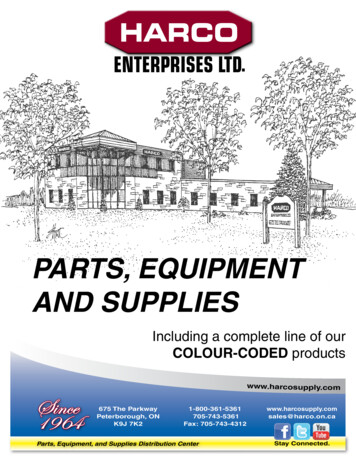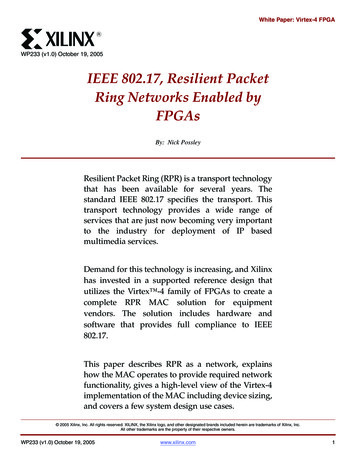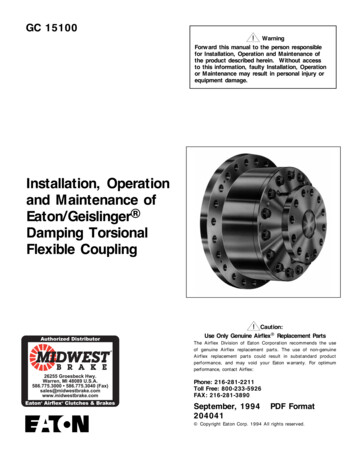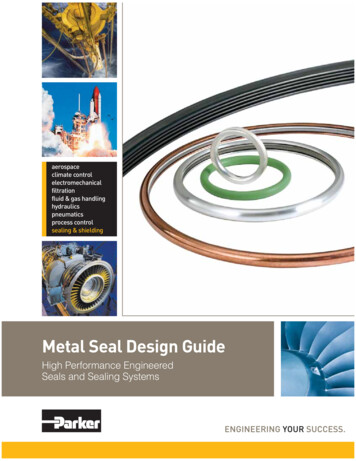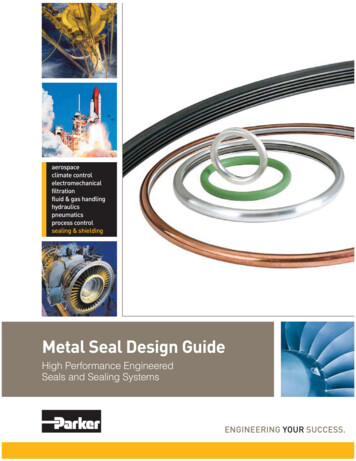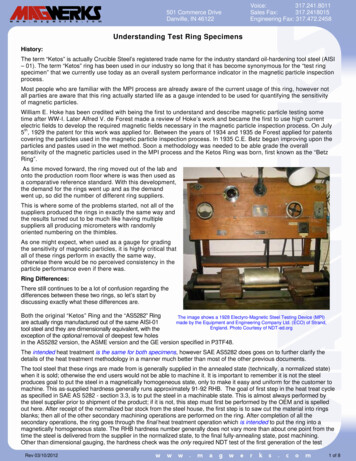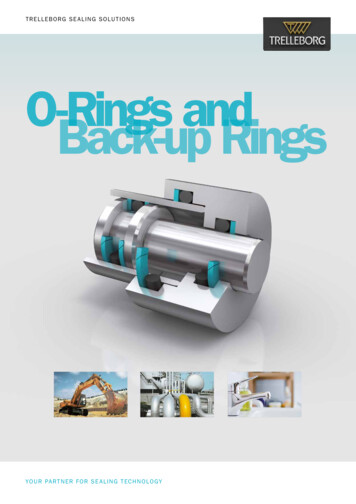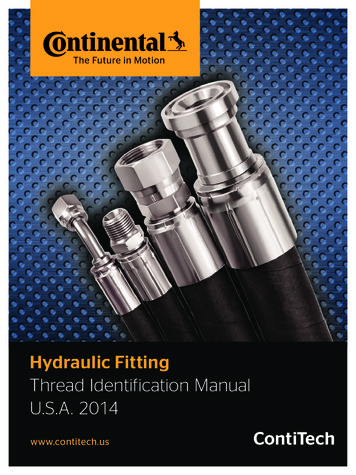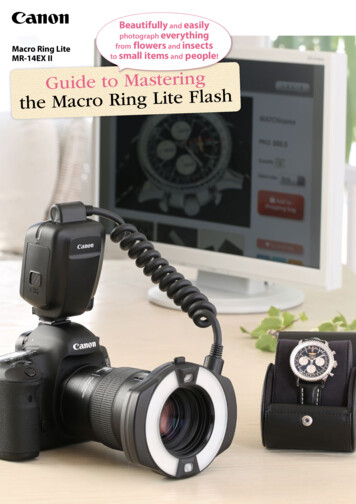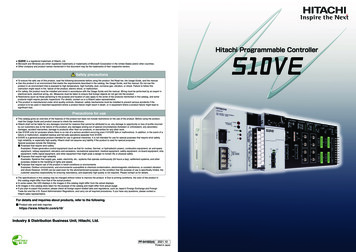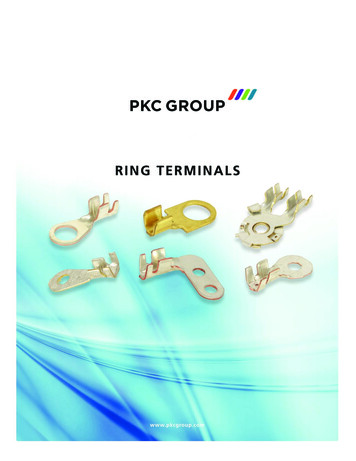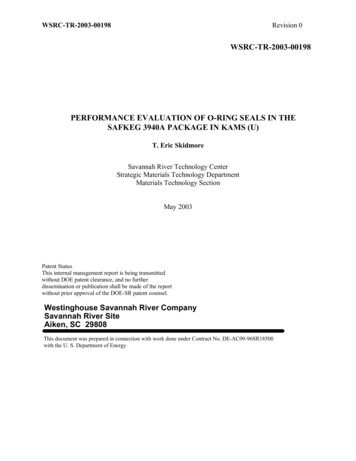
Transcription
WSRC-TR-2003-00198Revision 0WSRC-TR-2003-00198PERFORMANCE EVALUATION OF O-RING SEALS IN THESAFKEG 3940A PACKAGE IN KAMS (U)T. Eric SkidmoreSavannah River Technology CenterStrategic Materials Technology DepartmentMaterials Technology SectionMay 2003Patent StatusThis internal management report is being transmittedwithout DOE patent clearance, and no furtherdissemination or publication shall be made of the reportwithout prior approval of the DOE-SR patent counsel.Westinghouse Savannah River CompanySavannah River SiteAiken, SC 29808This document was prepared in connection with work done under Contract No. DE-AC09-96SR18500with the U. S. Department of Energy
This document was prepared in conjunction with work accomplished under Contract No.DE-AC09-96SR18500 with the U. S. Department of Energy.DISCLAIMERThis report was prepared as an account of work sponsored by an agency of the United StatesGovernment. Neither the United States Government nor any agency thereof, nor any of theiremployees, makes any warranty, express or implied, or assumes any legal liability or responsibilityfor the accuracy, completeness, or usefulness of any information, apparatus, product or processdisclosed, or represents that its use would not infringe privately owned rights. Reference herein toany specific commercial product, process or service by trade name, trademark, manufacturer, orotherwise does not necessarily constitute or imply its endorsement, recommendation, or favoring bythe United States Government or any agency thereof. The views and opinions of authors expressedherein do not necessarily state or reflect those of the United States Government or any agencythereof.This report has been reproduced directly from the best available copy.Available for sale to the public, in paper, from: U.S. Department of Commerce, National TechnicalInformation Service, 5285 Port Royal Road, Springfield, VA 22161,phone: (800) 553-6847,fax: (703) 605-6900email: orders@ntis.fedworld.govonline ordering: http://www.ntis.gov/help/index.aspAvailable electronically at http://www.osti.gov/bridgeAvailable for a processing fee to U.S. Department of Energy and its contractors, in paper, from: U.S.Department of Energy, Office of Scientific and Technical Information, P.O. Box 62, Oak Ridge, TN37831-0062,phone: (865)576-8401,fax: (865)576-5728email: reports@adonis.osti.gov
TABLE OF CONTENTSPage1.0SUMMARY.12.0BACKGROUND .12.1SAFKEG 3940A Package Design .12.2O-Ring Material Specification.42.3Service Conditions .43.0LITERATURE REVIEW .63.1EPDM Chemistry, Formulation and General Properties .63.2General Aging of Elastomers.83.3Thermal Aging of EPDM Elastomers.93.4Summary of Literature Review.144.0SEAL PERFORMANCE .154.1Seal Design .154.2Permeability .154.3Failure Criteria/Leak Testing.154.4Accident Conditions after Aging .164.5Baseline Characterization .165.0CONCLUSIONS AND RECOMMENDATIONS .176.0QUALITY ASSURANCE .177.0REFERENCES .18
LIST OF TABLESTable 1.Nominal Properties of Rainier Rubber O-Ring Compound# R0629-60.5Table 2.Bounding Conditions for SAFKEG 3940A and Model 9975 Packages .5
LIST OF FIGURESFigure 1.Overall Diagram of the SAFKEG 3940A Package Assembly.2Figure 2.Inner and Outer Containment Vessel Design.3Figure 3.Chemical Structure of EPR and EPDM Elastomers .6Figure 4.Ultimate Tensile Elongation vs. Aging Time for EPDM .12Figure 5.Normalized Compression Stress Relaxation vs. Aging Time for EPDM.12Figure 6.Stress Relaxation of Butyl and EPDM elastomers at 80 C .13
LIST OF ACRONYMS, TRADENAMES, AND S&CTISAFWSMSAmerican Society for Testing and Materialscompression stress-relaxationdesign basis accidentdose to equivalent damagediffusion-limited oxidationethylene-propylene diene monomerethylene-propylene rubberASTM designation for fluorocarbon rubberInternational unit of radiation absorbed dose, 1 Gray (Gy) 100 radInner Containment VesselInstitution for Electrical and Electronic EngineersHypothetical Accident ConditionsK-Area Materials StorageLos Alamos National LaboratoryMaximum Normal Operating PressureNormal Conditions of TransportOuter Containment Vesselparts per hundred rubber (elastomer compounding units)Radioactive Materialradiation absorbed doseRocky Flats Environmental Technology SiteSafety Analysis Report for a Packagestyrene-butadiene rubberSandia National LaboratorySavannah River Technology Centersand, slag, and crucibleThermal Insulating and Shock Absorbing FoamWestinghouse Safety Management Solutions
WSRC-TR-2003-001981.0SUMMARYThe purpose of this report is to document the technical basis for acceptance of the EPDM O-ringseals in the SAFKEG 3940A package proposed for storage of Pu-bearing material in the KAMS(K-Area Materials Storage) facility. Based upon limited available aging data, significant loss ofcompression set and stress-relaxation (90% or more) of the O-ring is possible at the maximumservice temperatures of the Inner Containment Vessel (112 C) within 2-4 years, assuming highoxygen availability. The maximum service temperature of the O-ring at the Outer ContainmentVessel (93 C) is less than at the ICV, and the O-ring compression set loss may not be as severeeven at the high oxygen availability condition. Under limited oxygen and static environmentalconditions, the O-ring seals may not exhibit this loss even after longer exposure periods.Baseline characterization of the O-rings in both high and low oxygen concentrations isrecommended in order to obtain compound-specific data at the relevant service temperatures.The characterization in combination with a surveillance program will help provide the dataneeded to assure long-term performance of O-ring seals under actual service conditions for thedesired 10 years.2.0BACKGROUND2.1SAFKEG 3940A Package DesignPu-bearing materials (metal, oxides, and impurities) placed in 3013 containers are to be shippedto SRS in Model 9975 packaging assemblies for interim storage at the K-Area Material Storage(KAMS) facility prior to final stabilization. An alternate package (SAFKEG 3940A) made byCroft Associates, Ltd. (est.1980) has been proposed for the same application. The 3940Apackage is one of a series of SAFKEG packages made by Croft for the packaging andtransportation of radioactive materials.The 3940A SARP (Safety Analysis Report for a Package) is in the process of being approved bythe Los Alamos National Laboratory (design authority) [1]. The 3940A package is a generalpurpose container for the shipment of Type B radioactive material. The 3940A package wasdesigned for a contents heat limit of 40 W, but the SARP is restricted to 20W.The 3940A package (Figure 1) consists of a double-skin insulated stainless steel keg that is 760mm (30 in.) long and 425 mm (16.7 in.) diameter [1]. The skin cavity is filled with a proprietaryinsulating phenolic resin foam (TISAF). Inside the keg is an insulating cork liner, sealed with aproprietary butylated sealant, that varies in thickness from 28 mm (1.1 in.) at the base of the kegto 75 mm (3 in.) at the top.Inside the cork liner is a double containment configuration of resealable vessels, designs 3941(outer containment vessel/OCV) and 3942 (inner containment vessel/ICV), Figure 2 [1]. Eachvessel is made of stainless steel and sealed with two 3-mm (0.118”) thick O-rings of appropriatesize. The interspace between them allows for leak testing. The containment boundary for each
WSRC-TR-2003-00198vessel is the inner O-ring. The lid is held in position by a threaded retaining ring, with both letinto the body of the container to reduce vulnerability of the closure. The nominal weight of thepackaging (excluding contents) is 108 kg (238 lb), with a maximum contents weight of 20 kg (44lb). The lid may be fitted with a padlock to prevent the unauthorized removal of contents.Figure 1. Overall Diagram of the SAFKEG 3940A Package Assembly [1].
WSRC-TR-2003-00198Figure 2. Inner and Outer Containment Vessel Design, SAFKEG 3940A Package [1].
WSRC-TR-2003-001982.2O-Ring Material SpecificationThe SAFKEG containment vessel O-rings are specified as EPDM (ethylene-propylene dienemonomer) per ASTM D2000, line call-out: M3 BA610 A14 B13 F17 [1]. ASTM D2000 is abroad specification for rubber products used in automotive applications [2]. The letter Mindicates metric (SI) units, followed by the grade number (3) and type BA material, whichgenerically includes ethylene-propylene, high-temperature SBR, and butyl rubber compounds.The three digits (610) are for hardness (6 60 5 Durometer Type A) and tensile strength (10 10 MPa (1450 PSI) minimum). The remaining designations are for specific heat resistance(A14), compression set (B13), and low-temperature resistance (F17) requirements.This differs from the 9975 package where only a particular compound is specified (ParkerV0835-75 based on Viton GLT) [3]. Therefore, O-rings from different manufacturers may beused in the SAFKEG as long as the ASTM requirements are met. Per Croft, the O-rings arecurrently supplied by the Rainier Rubber Company, Seattle, WA (compound# R0629-60). Thetechnical basis for the compound specification is unknown. Rainier would not disclose theformulation for proprietary reasons but did provide a recent QA material test report. Propertiesare summarized in Table 1 [4]. Per Croft, EPDM seals are now specified instead of Viton dueto superior low temperature performance. The properties of Parker V0835-75 are givenelsewhere [3,5]2.3Service ConditionsFor transportation, the two cases normally of concern are Normal Conditions of Transport (NCT)and Hypothetical Accident Conditions (HAC). The bounding design conditions for the SAFKEG3940A and Model 9975 packages are given in Table 2 [1,3]. The maximum NCT temperaturesfor the inner and outer vessel seals are 113 C (235 F) and 99 C (210 F), based on an ambienttemperature of 38 C (100 F) and solar heating [1].For storage in the KAMS facility, the temperature range is 0-120 F with no direct solar heating.The maximum normal storage temperatures for the SAFKEG 3940A inner and outer vessel sealsare 112 C (234 F) and 93 C (199 F), respectively [6]. Though these temperatures are muchlower than the continuous use rating of the O-rings (160 C/320 F) specified in the SARP, suchratings are typically only based on 1000 hours of exposure and vague property changes [1,7].Note that the 9975 package seal temperatures are lower than those of the SAFKEG underequivalent conditions, even though higher-temperature Viton seals are used.The radiation dose rates for the SAFKEG O-rings are unknown but assumed similar to thosepreviously calculated for the Model 9975 PCV seals (2 rad/hr for SS&C residues) [5,8,9]. Thisrate gives a total absorbed dose of 1.75E 05 rad over 10 years, far less than the level expected toproduce measurable property changes. However, dose rates for the SAFKEG seals could varydue to differences in package materials and geometry.
WSRC-TR-2003-00198The maximum normal operating pressure (MNOP) for both SAFKEG vessels is 8 bar/116 psi(abs). The maximum normal and design pressures for the 9975 vessels are much higher. Theleak rate criteria for both transportation and storage in KAMS is 10-7 bar std He cc/sec.Table 1. Nominal Properties of Rainier Rubber O-Ring Compound# R0629-60 [4](Material Specification: ASTM D2000: M3BA610 A14 B13 F17)PropertyTest MethodSpecification Tolerance Actual ValueHardness, pointsASTM D224060 /-559Tensile Strength, PSIASTM D4121450min.2000Elongation, %ASTM D412350min.510Tear Resistance, PPIASTM D624reportmin.244Shrinkage, %N/AreportN/A-2.33Specific GravityASTM D2971.09 /-0.031.09Compression Set, % (22 hrs at 158 F) ASTM D39525max.19.12Oven Aging, 70 hrs at 212 FASTM D573change in hardness, points(-)10max.64 ( 5)change in tensile, PSI(-)25max.1952 (-2.6%)change in elongation, %(-)25max.Low Temperature Brittleness:ASTM D2137 3 minutes at –40 CPass (nonbrittle)Table 2. Comparison of Bounding Conditions for SAFKEG 3940A and Model 9975 PackagesPackageBounding Design ConditionDesign Temperature, MinimumDesign Temperature, Maximum (NCT)Design Temperature, Maximum (HAC)Design Pressure, MinimumDesign Pressure, Maximum (external)Maximum Normal Operating PressureDesign Pressure, Maximum (internal)Seal Radiation Dose RatesSeal Temperature in Storage (@130 F)*SAFKEG 3940AModel 9975Bounding Design Condition Value(-) 40 F/ C(-) 40 F/ C147 C (297 F)200 C (402 F)200 C (392 F)200 C (402 F)0 bar abs (0 psia)0 bar abs (0 psia)2 bar abs (29 psia)365 psig (PCV)/166 psig (SCV)900 psi (PCV)/800 psi (SCV)8 bar abs (116 psia)2 rad/hr (TBD)2 rad/hrICV: 243 F OCV: 208 FPCV:202 F SCV:200 FReferences1,31,31,31,3131,3* The maximum temperature previously assumed for Viton seals in the 9975 PCV was 300 F, with 252 F (SCV)and 264 F (PCV) being the highest O-ring seal temperatures expected under NCT [3].96
WSRC-TR-2003-001983.0LITERATURE REVIEW3.1EPDM Chemistry, Formulation, and General PropertiesEPDM (ethylene-propylene diene monomer) is a synthetic elastomer developed in the 1960sprimarily for aerospace and automotive applications, particularly for resistance to phosphateester-based hydraulic fluids [7,10]. EPDM and EPR (ethylene-propylene rubber) polymers aremade by halting crystallization during ethylene-propylene copolymerization, thus stabilizing anelastomeric phase well below room temperature. EPR copolymers are amorphous and arecompletely saturated (no active sites), with chemical crosslinking only possible with peroxides.If a third monomer (a non-conjugated diene) is added during copolymerization, the resultingelastomer (EPDM) is unsaturated and can be vulcanized or crosslinked by either sulfur orperoxides, as well as high energy radiation. The chemical structure of EPR/EPDM polymers isshown in Figure 3.Figure 3. General chemical structure of EPR and EPDM polymers [11]As with most elastomers, there are many grades of EPDM available, depending upon theproperties required. The primary parameters include: the ethylene/propylene ratio, type andamount of termonomer, molecular weight (Mooney viscosity), and oil extension. For the mostpart, only three diene types are used: dicyclopentadiene (DCP), ethylidene norborene (ENB), and1,4 hexadiene (HX) [10]. The molecular weights of most commercial grades of EPDM arebetween 200,000-300,000, and the Mooney viscosity (ML 1 4 at 100 C) is between 25-100.Since in EPDM the unsaturation occurs only in side groups, the main backbone chain is fullysaturated, leading to excellent resistance to oxygen, ozone, and chemicals. However, additivesare required to maximize the aging resistance of EPDM but not for EPR.
WSRC-TR-2003-00198EPDM is non-polar and resistant to many chemicals including most salt solutions, alkalinesolutions, steam, dilute acids, acetone, alcohol, and phosphate ester-based hydraulic fluids.EPDM is not resistant to aliphatic, aromatic, or chlorinated hydrocarbons or petroleum-basedfluids and lubricants. It is also attacked by strong acids, particularly oxidizing types such asnitric [10].EPDM is generally resistant to temperatures of up to 300 F in air, with slightly highertemperatures tolerable with specific compounding or in certain environments [7,10]. EPDM isnot the most radiation-resistant elastomers, but it is usually the preferred elastomer for nuclearservice due to its combined resistance to radiation, chemicals, aging, steam, compression set,heat, and other factors [12]. Peroxide-cured EPDMs are generally preferred over sulfur-curedtypes for superior heat aging and radiation-resistance properties [10,12 ].For specific end-products such as O-rings, the compounder (e.g. Rainier, Parker Seals) procuresthe base raw polymer (ex. Nordel 1440) and incorporates curing agents (peroxides, sulfur) andadditives such as carbon black, antioxidants, UV/heat stabilizers, acid acceptors, and otherprocessing aids. EPDM is most commonly sold under the Nordel (DuPont-Dow Elastomers),Vistalon (ExxonMobil) or Royalene (Uniroyal Chemical) tradenames, with many individualcompounds available for specific needs. A typical EPDM formulation is shown in Table 2.Table 2. A typical peroxide-cured EPDM formulation [10].Constituentphr (parts per hundred rubber)Nordel 1440Zinc oxideN774 carbon blackParaffin oilDicumyl peroxide (40% active)1005125508EPDM vs. Viton O-rings based on Viton GLT fluoroelastomer (Parker V0835-75) are specified for the 9975shipping package, primarily for both high and low temperature ratings (-40 to 400 F).Generically, Viton fluoroelastomers (different types/grades) are more resistant to heat, flameand most chemicals than EPDM, particularly to acids, petroleum or hydrocarbon-based fluids,and solvents. EPDM is generally more resistant to amines, alkaline solutions and steam thanViton , and is more resistant to radiation. The room temperature mechanical properties of bothmaterials are comparable (compound-specific), with EPDM being more sensitive to elevatedtemperatures. EPDM typically exhibits better low-temperature performance, probably the basisfor its use in the SAFKEG. Both materials are highly resistant to aging, ozone and oxidation,with Viton being overall superior due to high fluorine content.
WSRC-TR-2003-001983.2General Aging of ElastomersAging of polymeric materials is a very complex subject. There are many variables that caninfluence the aging behavior of polymers, including: the base polymer type and specificformulation, heat, ionizing radiation (including ultraviolet), chemicals, ozone, and moisture. Thepresence and availability of oxygen is highly important, as oxidation is usually the dominantdegradation process. There are also possible synergistic effects of multiple variables, radiationdose rate effects, diffusion-limited oxidation (DLO) effects, and many other aspects whichfurther complicate such predictions.Elastomers are particularly difficult to evaluate due to variation in compound formulation andprocessing. Compounds of the same polymer and similar physical properties can exhibitsignificant differences in aging depending upon cure times and temperatures, incorporation ofadditives such as antioxidants, etc. The performance characteristics or requirements also have tobe considered, as some properties are more critical than others for a particular application anddifferent properties are usually affected at different rates.Continuous use temperatures often quoted by manufacturers are usually based on relativelyshort-term exposures (1000 hours or so) and nominal changes in properties [7]. While generallyuseful for designers and general material selection, such data is inadequate for predicting trueservice life, especially at elevated temperatures. Also, the criteria for such ratings may not besensitive enough for some applications.Historically, the thermal aging behavior of polymers and elastomers has been evaluated using anaccelerated-aging methodology, in absence of real-time aging data. This approach usuallyinvolves exposing the material at several different temperatures higher than the desired servicetemperature (usually ambient) and measuring specific properties after some period of time. Thismethodology normally assumes Arrhenius behavior, represented by the relation below:k exp (-Ea/RT) CWhere: k rate of reaction, Ea activation energy, R universal gas constant, T absolutetemperature, and C constantBy assuming a constant activation energy over the extrapolation range, the time to reach a certainproperty value at the desired temperature can be predicted by using shift factors (at exp (1/Tref– 1/T)) and superimposing data for the same property at elevated temperatures. This approach orprinciple is known as time-temperature superposition. Any property can be measured, withtensile strength, modulus, and elongation being the most common. However, these are notnecessarily the most sensitive or the most relevant for all applications.
WSRC-TR-2003-00198As with any material, the service life of an elastomeric seal is truly the point at which thematerial fails to serve its intended function. In this case, specific leakage rate requirements mustbe met. Unfortunately, this requires complex leak testing of seals to be performed at elevatedtemperatures and is not a direct measurement of physical property changes.The most important and relevant properties for elastomeric seals are generally considered to becompression set/recovery and compression stress-relaxation (CSR) or sealing force decay.Elongation-to-break is also a good indicator of degradation, but is not necessarily as sensitive oras relevant. High values of compression set (80-100%) or low values of retained sealing force(F/Fo 0.10) are often used as “failure” points, or levels of degradation at which seal integrity ishighly questionable. Elongation values such as 50% absolute or 10% of initial elongation arealso often defined as points of “failure”.Obviously, service life is also dependent upon the pressure differential and the nature of theapplication. Low pressure seals and those not subject to dynamic conditions are more tolerant ofmaterial degradation and loss in sealing force. In fact, seals with 100% compression set orstress-relaxation can still be highly functional unless disturbed. The more stringent the criteria,the more sensitive to degradation the seal becomes.Therefore, care must be taken in the definition of failure for elastomeric seals and the testmethods employed to evaluate seal performance. Comparison of data obtained by differentresearchers on different compounds under different conditions using different test methods andfailure criteria is of limited value.3.3Thermal Aging of EPDM ElastomersA review of available data on the aging of EPDM elastomers was performed. As in the 9975package and most cases of radioactive material (RAM) transport, the radiation levels expectedfor the SAFKEG seals are considered very low. In addition, most radiation-aging studiesevaluate materials at much higher dose rates than encountered in actual service and for greatercumulative doses. Therefore, the focus of this report is primarily on thermal aging. It must beemphasized that this data is very limited, compound-specific, and does not necessarily addressall relevant service conditions.In summary, most studies involve the use of accelerated aging methodology to evaluate theperformance of EPDM elastomers under ambient conditions, rather than focusing on agingbehavior at elevated temperatures. However, data on short-term exposures at elevatedtemperatures for a few EPDM compounds was found and is believed to be quite relevant for theSAFKEG package application.In a recent study [14], O-ring materials used in weapon systems were evaluated for thicknessvariability and compression set/recovery behavior after being compressed for one year attemperatures of 60, 70, and 80 C. At these temperatures, EPDM compound Parker E692-75exhibited an average compression set of 33% and 23% at 80 and 60 C, respectively, compared to
WSRC-TR-2003-0019815 and 13% for a Viton and 95 and 61% for a nitrile rubber compound. Unfortunately, highertemperatures and/or longer periods were not evaluated.Other references [15-18] document an extensive amount of short-term testing performed over theyears at Sandia National Laboratories in support of the Office of Civilian Radioactive WasteManagement (OCRWM) and the DOE Office of Defense Programs to evaluate the performanceof seals commonly used in radioactive material packages. These tests were performed at bothhigh and low temperatures for several commonly specified O-ring compounds. No workrelevant to aging was performed.In these studies, several O-ring compounds were evaluated, including EPDM (Parker Seal)compounds E0740-75, E0893-80, E0540-80, as well as Parker V0835-75 used in the 9975package. These compounds were leak tested at 380 F (193 C) for a 2 hour period with zerofailures. Relatively low compression set values (9-13%) were measured for the short exposures.Additional tests were performed at temperatures 30 F (17 C) higher than previous tests for a 3hour use period, again produced no failures.Low temperature testing was also performed, with only the Viton O-ring seals (V0835-75)producing failures at –40 C, the low temperature rating of the material. EPDM compoundsconsistently showed better low-temperature performance, maintaining leak-tight seals down to –50/60 C. While useful for package design, such data is of little value for the prediction of O-ringlifetimes.Perhaps most relevant to the SAFKEG package, one relatively recent study [19] investigated thelifetime prediction of EPDM O-rings for weapon components at ambient temperatures. EPDMO-rings were subjected to temperatures of 110 C to 155 C, with Arrhenius behavior observedover the experimental range. The EPDM compound evaluated in this study (SR793B-80) isbased on Nordel 1440 (DuPont-Dow Elastomers) and was custom-formulated for the AlliedSignal Kansas City Plant.Conventional extrapolation of this data to 25 C yielded significantly long lifetimes (55,000years). However, by using an ultrasensitive oxygen consumption analytical technique, activationenergy values were found to change in the extrapolation region by 30% (116 to 82 kJ/mol). Thisimproved methodology resulted in a predicted lifetime of 150 years at 52 C and 2000 years at25 C, reduced by a factor of 30 from conventional Arrhenius methodology.While still very encouraging for aging at ambient conditions, this study indicates lessencouraging long-term behavior of EPDM at elevated temperatures. Several properties of thiscompound were determined at 111 C, 125 C, 140 C, and 155 C (Figures 3 and 4). As shown inFigure 3, the ultimate elongation dropped from an initial 180% to essentially zero afterapproximately 200 days (6.56 months) at 125 C, only slightly above the maximum SAFKEGinner vessel seal temperature (112 C). At 111 C, the elongation value was essentially zero afterapproximately 1000 days (2.74 years). In this study, the authors defined the mechanical“lifetime” of these seals as about 2 years at 111 C based on the amount of degradation observed.
WSRC-TR-2003-00198For the same EPDM material, the normalized force decay (F/Fo, decay in sealing force betweenthe O-ring and mating surface) was determined at the same temperatures (Figure 4). Asignificant drop in sealing force was observed (F/Fo 0.1) after 200 days at 125 C and after 580days (1.59 years) at 111 C. From this data, the authors concluded that there is an “induction”period during which degradation is very limited, presumably due to the action of antioxidants.Other aspects of this study were documented in other references [20, 21].As with other studies, a major limitation of this data is that samples were oven-air aged incompression but with high oxygen availability. For lubricated O-rings sealed in a tight grooveexpanded at elevated temperature, the availability of oxygen for degradation is likely muchlower. Degradation rates are likely very dependent upon the oxygen partial pressure, thediffusion rate of oxygen and the consumption rate.It should also be noted that the EPDM compound used in this study has a much higher hardness(80A) than that specified for the SAFKEG package seals (60A). Variation in stress-relaxationbehavior for the softer SAFKEG O-ring material is unknown and should be determined.A subsequent study [22] extended the work from reference 19, applying laboratory test methodsto EPDM O-rings of the same material that had been in service at ambient weapon conditions for20 years. The mechanical "lifetime" of these O-rings was arbitrarily defined as the aging timerequired for the ultimate elongation of the material to reach 50% absolute (or about 10% ofinitial), which correlates closely with compression stress-relaxation properties.As shown in Figure 5, it took 70 days to reach an absolute elongation value of 40% (10% ofinitial) at 140 C. Significant changes in
Note that the 9975 package seal temperatures are lower than those of the SAFKEG under equivalent conditions, even though higher-temperature Viton seals are used. The radiation dose rates for the SAFKEG O-rings are unknown but assumed similar to those previously calculated for the Model 9975 PCV seals (2 rad/hr for SS&C residues) [5,8,9]. This
